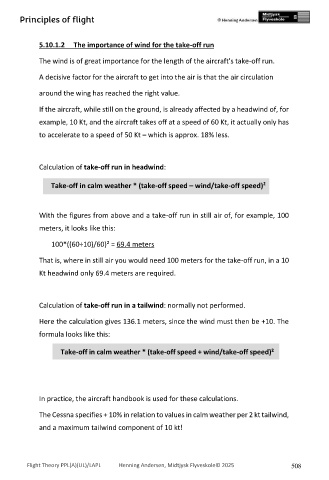Page 508 - PPL-engelsk 2025
P. 508
Principles of flight
5.10.1.2 The importance of wind for the take-off run
The wind is of great importance for the length of the aircraft's take-off run.
A decisive factor for the aircraft to get into the air is that the air circulation
around the wing has reached the right value.
If the aircraft, while still on the ground, is already affected by a headwind of, for
example, 10 Kt, and the aircraft takes off at a speed of 60 Kt, it actually only has
to accelerate to a speed of 50 Kt – which is approx. 18% less.
Calculation of take-off run in headwind:
Take-off in calm weather * (take-off speed – wind/take-off speed)
2
With the figures from above and a take-off run in still air of, for example, 100
meters, it looks like this:
100*((60÷10)/60)² = 69.4 meters
That is, where in still air you would need 100 meters for the take-off run, in a 10
Kt headwind only 69.4 meters are required.
Calculation of take-off run in a tailwind: normally not performed.
Here the calculation gives 136.1 meters, since the wind must then be +10. The
formula looks like this:
Take-off in calm weather * (take-off speed + wind/take-off speed)²
In practice, the aircraft handbook is used for these calculations.
The Cessna specifies + 10% in relation to values in calm weather per 2 kt tailwind,
and a maximum tailwind component of 10 kt!
Flight Theory PPL(A)(UL)/LAPL Henning Andersen, Midtjysk Flyveskole© 2025 508

